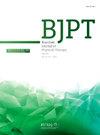通过临床友好措施评估跟腱病物理损伤:荟萃分析和GRADE推荐的系统综述
IF 3.2
3区 医学
Q1 ORTHOPEDICS
引用次数: 0
摘要
临床友好的测试,定义为负担得起的,便携的,容易获得的,可以促进评估和治疗跟腱病。目的通过临床友好的测试来识别跟腱病患者的身体损伤。方法在Medline、CINAHL、EMBASE、Web of Science和Sportdiscus中进行检索,使用临床友好的测量方法比较跟腱病个体和对照组的身体功能。使用Downs和Black量表评估研究质量,使用GRADE方法评估证据确定性。在可能的情况下,通过荟萃分析汇总数据。结果共纳入17项研究,其中12项有助于定量合成。荟萃分析显示,与无症状组相比,跟腱病患者有:膝关节弯曲的非负重姿势下的下踝关节背屈(平均差异[MD] = 5.22, 95% CI: 2.16, 8.28),抬跟时的下踝关节底屈耐力(MD = 10.47次重复,95% CI: 7.17, 13.76),以及下髋关节伸展等距强度(效应值= 0.49,95% CI: 0.12, 2.59)。在跟腱病变患者中,效应大小分析显示,与无症状组相比,跟腱角度和胫骨内翻更大,与无症状组相比,第一道线和足中外展松弛更大,与无症状组和肢体相比,跳跃能力受损。结论低至中等确定性证据表明,跟腱病患者踝关节背屈、下髋关节伸展强度、下踝关节足底屈耐力、跳跃能力受损、跟腱角度、胫骨内翻对齐、第一线和足中外展松弛。临床医生在评估跟腱病变患者时应考虑这些损伤。本文章由计算机程序翻译,如有差异,请以英文原文为准。
Achilles tendinopathy physical impairments evaluated through clinician-friendly measures: a systematic review with meta-analysis and GRADE recommendations
Background
Clinician-friendly tests, defined as affordable, portable, and readily available, can facilitate assessing and treating Achilles tendinopathy.
Objective
To identify physical impairments in individuals with Achilles tendinopathy using clinician-friendly tests.
Methods
Searches were performed in Medline, CINAHL, EMBASE, Web of Science, and Sportdiscus for studies comparing physical function between individuals with Achilles tendinopathy and controls using clinician-friendly measures. Study quality was assessed using the Downs and Black scale, and evidence certainty using GRADE approach. When possible, data were pooled through meta-analysis.
Results
Seventeen studies were included with 12 contributing to quantitative synthesis. Meta-analyses showed individuals with Achilles tendinopathy when compared with an asymptomatic group had: lower ankle dorsiflexion in a non-weight bearing position with knee bent (mean difference [MD] = 5.22, 95 % CI: 2.16, 8.28), lower ankle plantar flexion endurance on heel raises (MD = 10.47 repetitions, 95 % CI: 7.17, 13.76), and lower hip extension isometric strength (Effect Size= 0.49, 95 % CI: 0.12, 2.59). In those with Achilles tendinopathy, effect size analysis showed a greater Achilles tendon angle and tibia varus compared to an asymptomatic group, greater first ray and midfoot abduction laxity than the asymptomatic limb, and impaired jump performance compared to asymptomatic individuals and limb.
Conclusion
Low to moderate certainty evidence suggests those with Achilles tendinopathy have less ankle dorsiflexion, lower hip extension strength, lower ankle plantar flexion endurance, impaired hop performance, and greater Achilles tendon angle, tibia varus alignment, and first ray and midfoot abduction laxity. Clinicians should consider these impairments when assessing patients with Achilles tendinopathy.
求助全文
通过发布文献求助,成功后即可免费获取论文全文。
去求助
来源期刊
CiteScore
6.10
自引率
8.80%
发文量
53
审稿时长
74 days
期刊介绍:
The Brazilian Journal of Physical Therapy (BJPT) is the official publication of the Brazilian Society of Physical Therapy Research and Graduate Studies (ABRAPG-Ft). It publishes original research articles on topics related to the areas of physical therapy and rehabilitation sciences, including clinical, basic or applied studies on the assessment, prevention, and treatment of movement disorders.

 求助内容:
求助内容: 应助结果提醒方式:
应助结果提醒方式:


